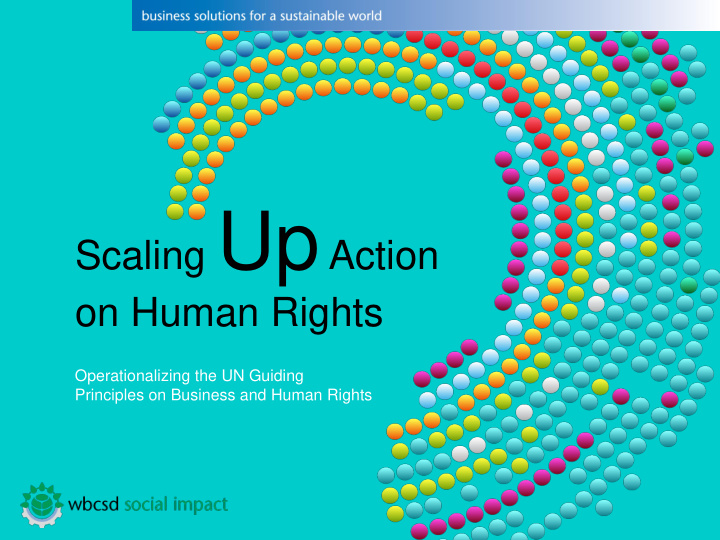



Scaling Up Action on Human Rights Operationalizing the UN Guiding Principles on Business and Human Rights
Why this issue brief? To encourage more companies to take action on operationalizing the UN Guiding Principles (UNGPs) by: Building an understanding of the current state of play amongst corporations Highlighting common barriers faced in implementing UNGPs Sharing solutions tried and tested by WCBSD members
Process The issue brief builds on three activities: Member survey – to understand the With support from current state of play within the WBCSD membership Member interviews – to understand challenges encountered & solutions being implemented In partnership with Member workshop – to enable “learning by sharing” and to identify common challenges & practices
21 contributing companies
What do the UN Guiding Principles mean for business? Policy commitment: adopted at the highest levels of the company, and embedded across and throughout the business enterprise Human rights due diligence : identifying, assessing, preventing and mitigating actual and potential human rights impacts on stakeholders Remedy: establishing or participating in appropriate mechanisms and processes to provide a remedy to affected stakeholders that may have suffered harm, where the company has caused or contributed to that harm Using their leverage: to encourage and incentivize their business relationships throughout the value chain to meet these expectations Meaningful stakeholder engagement: throughout all of these processes, engaging meaningfully with those stakeholders who may be adversely affected by the company’s activities
UN Guiding Principles: business case Meet growing expectations of investors, business partners, and governments Respond to the growing risk of reputational harm Avoid the commercial costs involved in human rights failures ‘Do the right thing’ and ensure that their social footprint is aligned with core corporate values Seize the opportunity to differentiate from competitors
5 key barriers for companies Barrier 5 Dealing with uncertainty in a new paradigm Barrier 1 Barrier 4 Making human rights Embedding understandable and in the business relevant Barrier 2 Barrier 3 Building internal Managing a complex ownership business environment and commitment
Tried and tested solutions Barrier 1 Making human rights understandable and relevant • Translate human rights into accessible language • Make the business case • Leverage a crisis
Tried and tested solutions Barrier 2 Building internal ownership and commitment • Assign responsibility and create a mandate • Leverage the policy commitment process • Link human rights to internal strategic priorities
Tried and tested solutions Barrier 3 Managing a complex business environment • Map human rights risks and impacts • Prioritize where necessary and learn by doing • Understand the supply chain
Tried and tested solutions Barrier 4 Embedding in the business • Understand the business of the business • Build on existing approaches • Share responsibility across the organization
Tried and tested solutions Barrier 5 Dealing with uncertainty in a new paradigm • Engage a critical friend • Communicate progress and challenges • Collaborate to address gray areas
The road ahead Advocate for company action to prevent, mitigate and address human rights impacts – importance of UN Guiding Principles Connect human rights more strongly to the wider sustainability agenda lined out under WBCSD’s Action2020 platform Facilitate practical engagement of companies through knowledge exchange and site visits
More information Download the issue brief in pdf format at: www.wbcsd.org/social-impact.aspx WBCSD contact point: Filippo Veglio, Director, Social Impact veglio@wbcsd.org
Recommend
More recommend